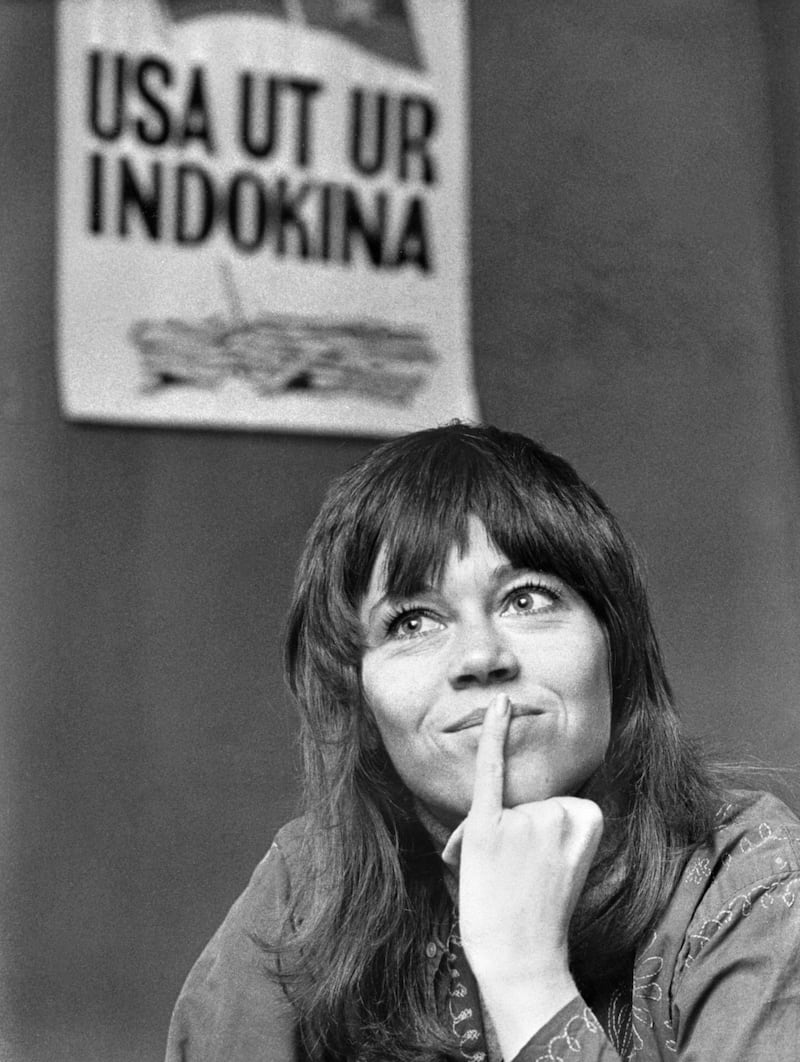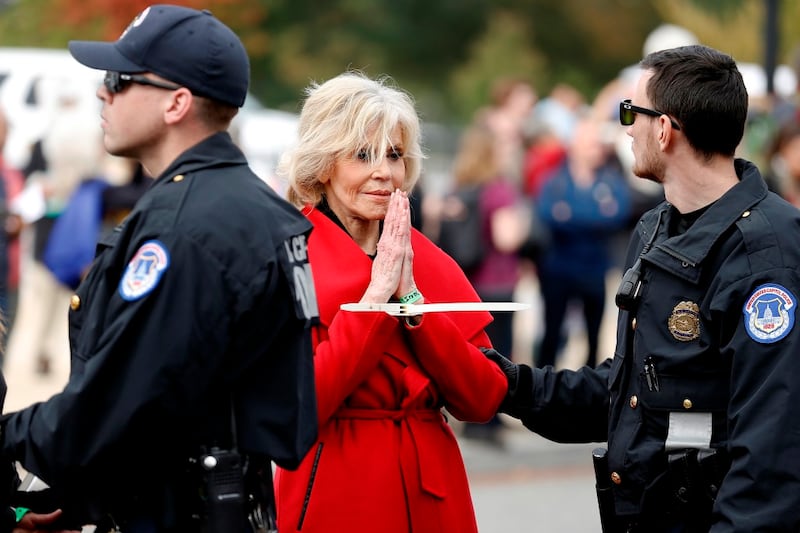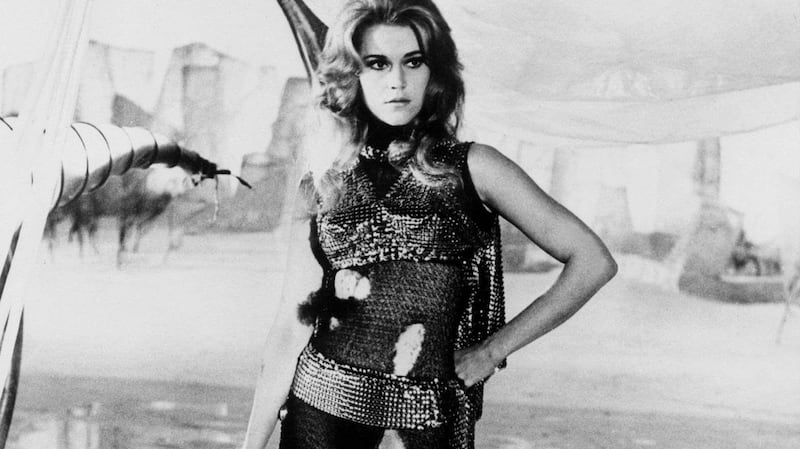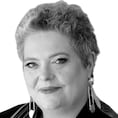When I log on to the video call with Jane Fonda (“Jane Flipping Fonda!” is what I’ve been muttering to myself, excitedly, all morning before the call) I’m surprised to find myself staring at a blank screen.
While I was excited about our conversation – two-time Oscar winner Fonda is, after all, a genuine star in the old-fashioned sense of the word – I was also looking forward to seeing her lovely famous, always-glamorous face.
When I told friends I was interviewing the actor, activist, fitness phenomenon and Grace & Frankie star, when they eventually stopped rhapsodising about what an utter legend she was, they inevitably spoke about how well she looked for her age. Fonda is a radiant 82.
But today she has decided to keep her camera off and I can only hear her voice, albeit a voice that’s immediately recognisable from movies, TV shows, podcasts and multi-million selling workout videos. A voice raised on countless rousing protests over the decades most recently in Washington DC where in October last year, inspired by Greta Thunberg and other young people, she launched the climate-change initiative Fire Drill Fridays, getting arrested on the steps of Capitol Hill wearing a red coat she bought on sale. Fonda, the coat and Fire Drill Fridays made headlines all over the world.
More than most people, Jane Fonda is wholly entitled to put her feet up with a nice cup of cocoa at this stage of life. She shows very little sign of it though.
I can’t see her on the video call but she can see me. A couple of minutes into our conversation she takes the time to ask how I pronounce my name so she can address me correctly, a courtesy not every famous person would be bothered with.
“It’s Row and Sheen,” I tell her.
“Okay, Rowsheen,” she repeats carefully.
And while not being able to look at Jane Fonda while we speak is a little disappointing, after a while I forget about it as I listen to her passionate and pragmatic stories beginning with why, as an octogenarian, she is still trying to change the world decades after first coming to the world’s attention as an activist when she was controversially photographed on an anti-aircraft gun in Vietnam in 1972.
That notorious escapade earned her both years of approbation in some circles for “shaming” American troops and the nickname Hanoi Jane.
Starting with her support for Native Americans and the Black Panthers in the 1960s, the star of movies such as Barbarella, 9 to 5 and, with her father Henry Fonda, On Golden Pond, has been shouting about injustice, inequality and discrimination for most of her life, raising awareness about everything from violence against women to the Iraq war, fair wages and Richard Nixon.
The former president reportedly had Fonda arrested on spurious charges, giving rise to Fonda’s famous, shaggy haired, fist-in-the-air police mugshot. Arrested on suspicion of smuggling drugs and assaulting a customs officer at Cleveland Airport in 1970, it later emerged that the “drugs” were vitamins.
All of this is to say that, more than most people, Jane Fonda is wholly entitled to put her feet up with a nice cup of cocoa at this stage of life. She shows very little sign of it though.

Her new book, What Can I Do? My Path from Climate Despair to Action, recounts the story of her latest and perhaps most important, certainly most existentially gruelling, project. For the past few years Fonda, who describes herself as being in the “fifth act” of her life, has been trying to save the planet and now she has written a sort-of handbook for anyone who’d like to do the same.
The book has lots of pictures of her famous friends being arrested along with her on some of the 14 Fire Drill Fridays –Ted Hanson, Sally Fields, Joaquin Phoenix and Susan Sarandon for some examples – but, more importantly, it’s full of the voices of experts and often unheard voices from the front line of climate activism. In 2019, the book blurb explains, “atmospheric concentrations of greenhouse gases hit the highest level recorded in human history and our window of opportunity to act is quickly closing”.
I cannot stand to see a bunch of greedy, rich, cisgender, white guys destroying the planet
Fonda’s motivation couldn’t be clearer: “This climate crisis is going to determine whether there is life on Earth. I’m not going to be alive for that. But I have an 11-month-old grandchild. And I love humanity and I love nature,” she says.
“And I cannot stand to see a bunch of greedy, rich, cisgender, white guys destroying the planet and the atmosphere knowingly, people who know what they’re doing and are doing it anyway. In order to get more money. It just haunts me and I will not stop until I’ve done every single thing I can to try to change that.”
When we speak, the now looming US election is still several months away but the spectre of climate-change denier Trump – “greedy, rich, cisgender, white” – lingers over Fonda’s conversation like a bad smell.
Being a “white, famous, woman” is something she has used for decades, understanding early on her power in drawing attention to issues. “Because I’m a movie star, I have a platform that’s bigger than other people. And I feel like I have an obligation to use that platform.”
In the first chapter of the book, Fonda recalls how, in the autumn of 2019 after reading Naomi Klein’s book On Fire, she had an epiphany. She was on a hiking holiday in the hills of California with actor friends Rosanna Arquette and Catherine Keener. She was depressed. Despite having cut down drastically on her meat consumption, stopped using single-use plastics and switched to an electric car, she felt she was not doing enough for the cause.
In her book, Klein argued that the Green New Deal proposed by politicians such as Alexandria Ocasio-Cortez was at the heart of solving the climate crisis. As she hiked with friends by day and read Klein by night, Fonda was consumed with the huge question that became the title of the book: What Can I Do?
“I felt it so strongly, I was quivering all over,” she writes. She told Keener and Arquette over dinner one evening that she was going to move to Washington DC and camp out in front of the White House to protest Climate Change. “If Greta can do it,” she said. “So can I.”
Fonda moves fast. Within days she had garnered the support of Annie Leonard, an executive director of Greenpeace, and Bill McKibben of the 350.org – both loom large in the book – and Klein herself. They came up with a series of weekly acts of civil disobedience, risking arrest, that they named Fire Drill Fridays. Then she moved to Washington.
It was a leap of faith but as Fonda, who has had three hip replacements, points out, “Leaps of faith are my only form of exercise these days.”
Fonda and the diverse Fire Drill Friday team take a forensically intersectional approach to the issue. There are chapters that explore the links between climate crisis and the patriarchy, or climate crisis and racism, or climate crisis and the banking system, which means that all the environmental dots are joined up in the book. “This is an all-out war on drilling and fracking and deregulation and racism and misogyny and colonialism all at the same time.”

As Fonda puts it, “in a radical situation, radical action is the moderate thing to do”.
I ask what she learned about herself during this eventful time. She was arrested five times although treated with “kid gloves” in the police station on account of being white and famous.
Each week she hosted Think Ins where the issues were teased out and explored. (The strict rule for these meetings was that speaking panels could neither be all-male nor all-white.)
She says she already knew she was resilient but what she and others involved hadn’t understood as deeply before was the transformative power of engaging in civil disobedience. “Good trouble,” she calls it. As she was being led away by police the first time, a reporter asked her: “Why have you done this? Gone to jail?” and Fonda replied, “To get you to cover climate.”
I don't want to say paddy wagon because that's demeaning to the Irish and I love the Irish
She says: “It seems counterintuitive because when the police put handcuffs on you, you’re in their control, you have no more control. But you are aligning your whole body with your deepest values, it’s hard to find ways to do that in regular life. But you are risking who knows what, by doing this, by being put into a paddy wagon.”
She corrects herself. “I don’t want to say paddy wagon because that’s demeaning to the Irish and I love the Irish.” She goes on to list her Irish-loving credentials and reminisce about her visits to Belfast and Derry with former activist husband Tom Hayden.
But back to being arrested. “You’re strapped in and you have to kind of bend over in a position of submission. Everything is done to humiliate. And yet you feel empowered. Because you understand why you are there. You have put your body on the line for something you believe in. And people came from all over the country who had never done this before in their lives, who joined with me. And I talked to so many of them afterwards, and they felt transformed. And the depth of that surprised me.”
The book is a manual, a call to action, a bible for environmental beginners on how to get involved in climate justice. One hundred per cent of the author’s net proceeds from What Can I Do? will go to Greenpeace.
The book is also a clarion call to older women, one of the fastest-growing demographics in the world. Fonda says older women are the “core” of the movement. “They’re not afraid to be angry and have less to lose.”
The book includes tips for those looking to get arrested such as to wear several layers of clothing. Fonda’s red coat had no pockets so she kept her money and driver’s licence in her bra. The book is so passionately argued, her story is bound to inspire thousands of more mature people – people of all ages really – to put their bodies on the line for the planet.
Fonda is as fascinating, well-read and passionate on climate change and global warming and fracking and fossil fuels, as you’d expect. But talk to her for any length of time and you end up getting so much more than a brilliantly framed environmental lecture. Relationship stories, self-help wisdom, fitness and, of course – because you can’t talk to Jane Fonda and not pick her brains on this – advice on ageing well.
The three-times-married sister of the late actor Peter and daughter of Hollywood great Henry – she has spoken about him as being “distant” and of reconciling with him before his death – starred in acclaimed movies such as They Shoot Horses Don’t They?, Klute and Coming Home. She won Best Actress Oscars for the latter two films and was nominated for five others.

A recent HBO documentary about her life called Jane Fonda in Five Acts looked at, among other things, the huge influence her father and her three husbands had on her life: her first husband French director Roger Vadim directed her in Barbarella; her second, the activist Hayden, had those Irish links; and her third was billionaire CNN founder Ted Turner.
Each one informed her activism in different ways. She has described herself as being “a student” in her marriages. It was only in later years that she came into her own as an activist and leader.
It took time to get there. Fonda doesn’t shy away from explaining the previously pampered, navel-gazing existence as the daughter of Hollywood royalty and a star herself, or about how she willed herself out of that comfort zone.
“I was about 23 years old, and I felt that I was extremely selfish,” she says. “I wanted to change. And so I said, I’m going to pretend to be generous. And if you pretend long enough, you kind of become that. And it’s interesting. I mean, actually, your brains are very plastic. And if you change the way you think about something, your brain changes and it becomes your new reality.
“I studied how people change. You know, it’s something that really interests me…privilege and wealth doesn’t make you happy. Neither does poverty. It’s easier if you’re healthy because you can afford therapists. At least you know where your next meal is coming from.
“But rich or poor, what matters is how your parents treated you. If your parents really knew how to love you, and not all parents know how to love – not because we’re bad people. It’s because they weren’t loved.”

She talks then about her parents and her childhood which, from the outside, appeared enviable, a real life American Dream. “So much of who we are depends on how our parents treated us. Whether they were narcissistic, whether they were capable of love, whether they know how to show up for their children.
“And if they didn’t, then you have to spend a whole lot of time healing from those wounds which I have. And so, you know, the older I get, the more healed up I am because I’ve been working on it.”
The moment I read about my mother, everything fell into place, all of her plastic surgeries, all the promiscuity – everything, her inability to trust and show up, everything became clear, and I could forgive her
We talk about her troubled mother, New York socialite Frances, who died by suicide aged 42, when Fonda was just 13. While writing her memoir, Fonda went back to the institution her mother was living in when she died. Looking through their records she discovered that her mother had been sexually abused as an eight-year-old child.
“And oddly enough, about five years prior to that I had started an organisation in Georgia, where I was living at the time. And it’s called the Georgia Campaign for Adolescent Power and Potential, which deals a lot with teenage pregnancies and teenage sexuality. And one of the things that I learned is that if you saw a girl 15 years or younger who was pregnant or had had a child, you could bet your bottom dollar that she had been sexually abused as a child.
“I had studied that in depth, I was a lay expert on the issue of childhood sexual abuse. So the moment I read that about my mother, everything fell into place, all of her plastic surgeries, all the promiscuity – everything, her inability to trust and show up, everything became clear, and I could forgive her. And, of course, forgiveness is the most liberating of all.” She has spoken before of her own abuse as a child, and subsequent debilitating eating disorders which dogged much of her early life.
It makes sense that in the HBO documentary her son Troy is quoted as saying his mother’s lifelong activism “keeps her demons at bay”.

I’m curious about what sustains Fonda in all of this, whether she is a spiritual person. “I believe in prayer. I believe in meditation,” she says. “They’re not quite the same, but they’re close. Things can happen if you are praying for real, and when you meditate regularly. You become clearer, you become more centred and you manifest...it’s important to manifest.”
Faith, Fonda elaborates, is the understanding that you are “a part of the cosmos, part of something bigger than yourself and when you really understand and metabolise that understanding, then nothing can touch you.”
I tell Jane Fonda that my mother, Ann, is a similar age to her, and that her ambition is to reach the age of 100. Does she have the same aspiration?
“You know, I didn’t until recently,” she says. “Gloria Steinem is a friend of mine, and she always says, I want to live to 100. And I would say why? And she says ‘I want to see how it turns out.’ And I’ve come to agree with her. I’d like to live to 100.”
Then she sounds a note of caution: “I’m not sure that I will, though. I’ll tell you why. I wrote a book that I love a lot called Prime Time, about the second half of life, the older years, which I think is a really, really good book.
“And I encourage people to read that along with my new book. But at any rate, I interviewed a lot of people. I was living in Atlanta at the time, and Atlanta has a centre for centenarians, people over 100. I interviewed a number of people who were 104 and 106 and they all had one thing in common: a sense of humour. They all had this incredible attitude. That was so beautiful.
“And I don’t know…I come from a long line of depressed people. I don’t know if I’m going to be able to sustain myself past 100 but I want to see how it turns out too.”
She talks about the importance, in ageing well, of working hard to stay healthy but also of making your life “deeper and wider”.
“And so assuming good health…what you can do is become deeper and wider as a human being. And that requires, I think, choosing carefully what you read. Reading things that will teach you and inspire you and deepen you and then the people you are with is important.

“I make a point of it, my friends are mostly younger than me. They’re smarter than me. They’re more strategic than I am. And I don’t know if they’re braver than me, but they’re brave. And so I learned from them and I’m inspired by my friends and who your friends are makes a big difference, I think.”
Even in lockdown the Fire Drill Fridays continue, garnering audiences of up to a quarter of a million people as she interviews climate activists and experts, using her own copy of What Can I Do? as a “now very dog-eared” handbook.
She is looking forward to getting back to filming yet another season of Netflix’s longest running series Grace and Frankie with her “great friend” Lily Tomlin. “My life will be less busy when I get back to work,” she says. “I spend half my life on Zoom now raising money, hosting talks.”
If you look at your wounds and you try to heal them, that's where you can become stronger
Would she still recommend her famous, multi-million selling workout for those looking to keep fit? The workout was deceptive. On the surface, it was bouncy haired Fonda in a skimpy leotard getting sweaty, but in reality the best-selling VHS raised $17 million to combat poverty and racism and corporate malpractice as part of the Campaign for Economic Democracy.
“It depends what age you are,” she says. “If you are young, absolutely. Sheltering at home, a lot of people have gone back to my workout. But the moves might be too fast for people who are older. What I do now is some of the same moves but slowly.
“When I was doing the workout and lifting weights I found out the reason you shouldn’t use the same body parts is because when you lift weights, it causes microscopic tears. Think of them as wounds in your muscles. And it takes 48 hours for those to heal, and when they heal, they’re stronger. And that’s kind of a metaphor for life. If you look at your wounds and you try to heal them, that’s where you can become stronger.
“What matters is to keep moving and do it quite intentionally.” she says.
Keep moving. Do it quite intentionally.
I don’t need to see her lovely famous face on my computer screen to understand that this is exactly what Jane Fonda has been doing her whole life.
She is not going to stop now.
What Can I Do? My journey from Climate Despair to Action by Jane Fonda is out now



















